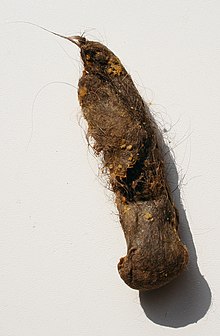Rapunzel Syndrome

| Classification according to ICD-10 | |
|---|---|
| T18.2 | Foreign body in the stomach |
| T18.3 | Foreign body in the small intestine |
| ICD-10 online (WHO version 2019) | |
When Rapunzel syndrome - named after the fairy tale Rapunzel the Brothers Grimm - it is an extremely rare treated in the medical literature syndrome , which manifests itself in the fact that a person eats (its own) hair. Since hair is indigestible, it accumulates in the stomach. It was first described by Vaughan in 1968. By 1999, eleven cases had been described worldwide. The syndrome is mainly found in younger girls with trichophagia , whose psychodynamic background is often an expression of early childhood deprivation with high comorbidity to serious child psychiatric diseases.
The symptoms of the syndrome are non-specific and can simulate other gastrointestinal diseases: sliding tumor in the upper abdomen, weight loss, alopecia . They are triggered by a trichobezoar (ball of hair) in the stomach, which can extend into the small intestine with a "pigtail-like" extension, and in extreme cases into the large intestine . Gastric perforation , intestinal obstruction or wall necrosis of the small intestine can result in complications with fatal outcome .
Therapy is carried out by surgical removal ( gastrotomy ) of the trichobezoid.
90% of trichobezoars are found in girls younger than 20 years old, who usually have trichotillomania . Since trichophagia is far more common than the formation of a trichobezoar, the reasons for its development are largely unknown. In addition to the amount and length of the swallowed hair, a change in the mucous membrane crypts of the stomach or their secretions should also be of decisive importance.
literature
- I. Gockel, C. Gaedertz, HJ Hain, U. Winckelmann, M. Albani, D. Lorenz: The Rapunzel Syndrome. A rare manifestation of a trichobezoar of the upper gastrointestinal tract (The Rapunzel syndrome: rare manifestation of a trichobezoar of the upper gastrointestinal tract). In: surgeon. Volume 74, Issue 8, 2003. doi: 10.1007 / s00104-003-0680-0 . Pp. 53-56
- E. Matějů, S. Duchaňová, P. Kovac, N. Moravanský, DJ Spitz: Fatal case of Rapunzel syndrome in neglected child. In: Forensic Science International. Volume 6, 2009. PMID 19505779 .
- ED Vaughan Jr, JL Sawyers, HW Scott Jr .: The Rapunzel syndrome. An unusual complication of intestinal bezoar. In: Surgery . Volume 63, Issue 2, 1968, pp. 339-343, PMID 5638179 .
Individual evidence
- ↑ a b Alphabetical directory for the ICD-10-WHO version 2019, volume 3. German Institute for Medical Documentation and Information (DIMDI), Cologne, 2019, p. 885.
- ^ I. Gockel, C. Gaedertz, HJ Hain, U. Winckelmann, M. Albani, D. Lorenz: The Rapunzel Syndrome. A rare manifestation of Trichobezoars the upper gastrointestinal tract (The Rapunzel syndrome: rare manifestation of a trichobezoar of the upper gastrointestinal tract) (= surgeon . Band 74 , no. 8 ). 2003, p. 53-56 , doi : 10.1007 / s00104-003-0680-0 .